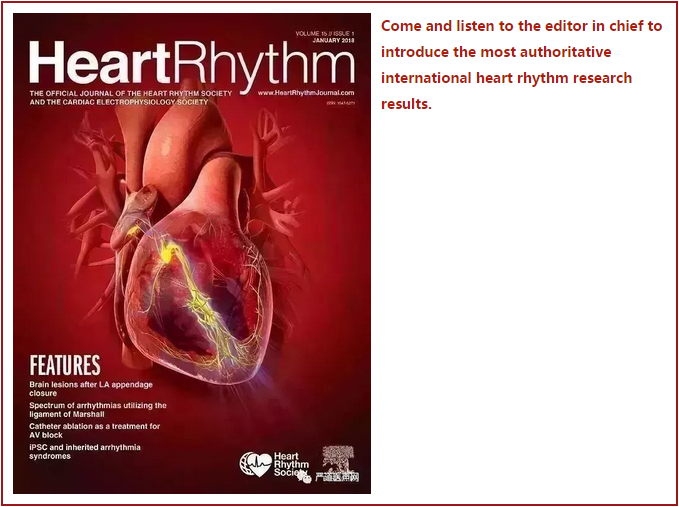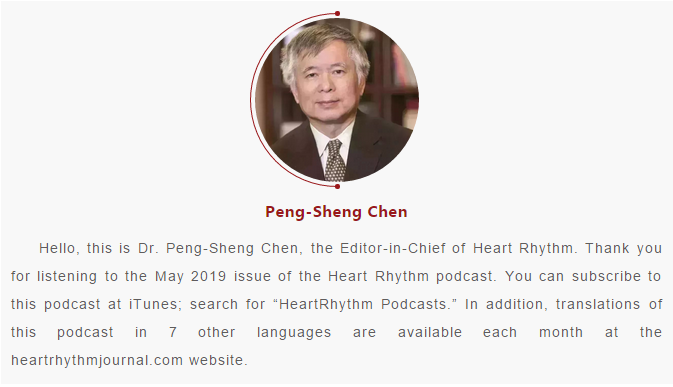<< First issue in May 2019 >>


1
The 40th Scientific Session of the Heart Rhythm Society will be held in San Francisco this month. The May issue of the journal starts with an editorial by Drs Thomas Deering and Igor Efimov entitled, “Heart Rhythm Society - 40th Anniversary: A History of Success”. The article briefly summarizes the society’s contribution to research, education, clinical care, and advocacy.
2
The featured article this month is a contemporary review titled “Troubleshooting and Programming Considerations for Permanent His Bundle Pacing” by Daniel Lustgarten et al. from The University of Vermont. An accompanying video author interview conducted by our online editor, Dr. Daniel Morin, can be found at the www.heartrhythmjournal.com website. Interest in permanent His bundle pacing is steadily growing. This review focuses on critical considerations and troubleshooting options available to the implanter and device clinic personnel.
3
The next paper is titled “Left Atrial Appendage Closure Device Implantation in Patients with Prior Intracranial Hemorrhage” by Hutt et al from the Cleveland Clinic. Patients with AF and prior intracranial hemorrhage were excluded from clinical trials of LA appendage closure devices, due to perceived risks of peri-operative anticoagulation. The authors report that they implanted the LA closure device in 38 consecutive patients with AF and prior intracranial hemorrhage. They found that AF patients with prior intracranial hemorrhage tolerated short-term anticoagulation for the purpose of LA closure device implantation. This procedure is both safe and effective in this patient population. However, the ideal regimen of anticoagulation and antiplatelet therapies for this patient population remains to be elucidated.
4
Coming up next is “Epicardial connection between the right-sided pulmonary venous carina and right atrium in patients with atrial fibrillation” by Yoshida et al, Ibaraki Prefectural Central Hospital, Japan. Ablation of the pulmonary venous carina is occasionally required for PV isolation. The authors performed intracardiac mapping in sinus rhythm to determine the left atrial breakthrough sites, including Bachmann’s bundle, the fossa ovalis, and the right-sided PV carina. They found that PV isolation was not achievable without carina ablation in one-fifth of patients, probably because of epicardial connections present between the right-sided PV carina and right atrium. Local anatomical variations of the muscle bundles in that region observed in previous autopsy studies may explain these findings.
5
Next up is “Characterizing localized reentry with high resolution mapping: evidence for multiple slow conducting isthmuses within the circuit” by Frontera et al from Haut Leveque Hospital, Pessac, France. The authors studied 15 localized re-entry atrial tachycardias with high resolution mapping. They found that localized atrial reentry circuits have multiple sequential “corridors” of very slow conduction which contribute to maintenance of arrhythmia. Although the entire circuit was of relatively low voltage, the bipolar voltage in slow conducting corridors had an extremely low voltage: only 0.22 mV, which was significantly lower than the rest of the circuit that averaged 0.50 mV. This information could potentially be used to design automatic mapping programs to facilitate the diagnosis, localization and ablation of the most vulnerable targets.
6
Linares et al from the University of Illinois at Chicago wrote the following article titled “Prevalence of Atrial Fibrillation and Association with Clinical, Sociocultural and3Ancestral Correlates Among Hispanic/Latinos: The Hispanic Community Health Study/Study of Latinos”. They found that the overall AF prevalence among latinos was only 1.0%. The prevalence varied significantly across Hispanic/Latino background groups independent of clinical or demographic factors. The lowest was among those of Mexican background, at 0.3%. In comparison, the AF prevalence in non-Hispanic Whites was estimated to range from 2.3-3.4%. These and many previous studies indicate that racial and ethnic background is important for risk of development of AF.
7
The next article is titled “Obstructive sleep apnea is associated with non-sustained ventricular tachycardia in patients with hypertrophic obstructive cardiomyopathy” and was written by Wang et al from Fuwai Hospital, Beijing, China. The authors performed polysomnography and Holter electrocardiography in 130 patients with hypertrophic cardiomyopathy. Half of them had obstructive sleep apnea. The prevalence of nonsustained VT increased with the severity of obstructive sleep apnea. Because nonsustained VT is a risk factor for sudden death in this population, these findings suggest that successful treatment of obstructive sleep apnea may improve outcomes of these patients.
8
Coming up next is “Left ventricular activation-recovery interval variability predicts spontaneous ventricular tachyarrhythmia in heart failure patients” by Porter et al from King’s College London. The authors studied 43 patients with heart failure and implanted a CRT defibrillator. Activation-recovery intervals as a surrogate for APD were recorded from the left ventricular epicardial lead while pacing from the right ventricular lead to maintain a constant cycle length. They found that increased left ventricular activation-recovery interval variability is associated with an increased risk of VT/VF in patients with heart failure. The results of this study further support the hypothesis that increased repolarization variability may be used for risk stratification of patients at risk of sudden death.
9
Fuchs et al from Vanderbilt University wrote the next article, titled “Incidence and Impact of Early Postoperative Ventricular Arrhythmias after Congenital Heart Surgery”. The authors sought to determine the incidence of in-hospital ventricular arrhythmias following congenital heart disease surgery and then to assess the clinical relevance of these arrhythmias during the postoperative hospital course. The study included 1835 patients. They found 18.5% had ventricular arrhythmias. The presence of treated ventricular arrhythmias was an independent risk factor for in-hospital death, with odds ratio 2.44. The presence of arrhythmia that needs treatment may worsen outcomes. However, whether or not the treatment itself contributed to the increased mortality cannot be completely ruled out.
10
The next article is “A Novel Pacing Maneuver to Verify the Post-Pacing Interval Minus the Tachycardia Cycle Length While Adjusting for Decremental Conduction” written by Kaiser et al from El Camino Hospital, Mountain View, California. The post-pacing interval (PPI) minus the tachycardia cycle length (TCL) is frequently used to investigate tachycardias. The authors studied AVNRT or orthodromic reciprocating tachycardia patients using a “dual chamber entrainment” formula. Entrainment was confirmed when the opposite chamber accelerated to the pacing cycle length and the tachycardia resumed after pacing was discontinued. A dual chamber entrainment PPI-TCL value >80 ms favors AVNRT over orthodromic reciprocating tachycardia. This maneuver can be used to verify the observed PPI-TCL value in challenging cases.
11
Coming up next is “Variant of Ventricular Outflow Tract Ventricular Arrhythmias Requiring Ablation From Multiple Sites: Intramural Origin” by Di Biase et al from St. David’s Medical Center. Austin, Tx. A total of 116 patients undergoing ablation for symptomatic LVOT ventricular4arrhythmias were enrolled in this study. Among them, 15 were found to have multiple equally early activation sites. Sequential ablation of all the early activation sites was possible in 14 patients, resulting in complete arrhythmia suppression. The authors conclude that intramural LVOT ventricular arrhythmias manifesting with multiple early activation sites require ablation at all sites to achieve acute and long-term success, particularly if none of the early sites is mapped at than more than 30 ms pre-QRS. While the sample size is small, this study provides practical guidance to ablating these arrhythmias.
12
Next up is “Outcomes Following Implantable Cardioverter-Defibrillator Generator Replacement in Patients with Recovered Left Ventricular Systolic Function: the National Cardiovascular Data Registry” by Thomas et al from UC San Diego. The authors evaluated 26 thousand Medicare beneficiaries enrolled in the NCDR ICD Registry who underwent primary-prevention ICD generator replacement. At the time of generator replacement, 7.3% of patients had completely recovered and 17.5% had partially-recovered left ventricular ejection fraction. These patients have a lower risk of mid-term adverse outcomes compared to those with reduced LVEF following ICD generator replacement. However, although the risk is lower, whether or not these lower risk patients can still benefit from ICD generator change remains unknown.
13
Spinale et al from University of South Carolina wrote the following paper titled “Development of a Biomarker Panel to Predict Cardiac Resynchronization Therapy Response: Results from the SMART-AV Trial”. A CRT response was pre-specified as a ≥15 mL reduction in LV end-systolic volume. The authors studied 74 candidate proteins which yielded 12 candidate biomarkers, but only a subset of these demonstrated predictive value for CRT response. These proteins are the soluble suppressor of tumorgenicity-2, or “ST2”; soluble tumor necrosis factor receptor-II, or TNF receptor 2; matrix metalloproteinases-2, or MMP-2; and C-reactive protein, or CRP. These findings hold potential for point of care testing and integration into evaluation algorithms for patients being considered for CRT. A prospective study will be needed to determine if these biomarkers can improve the prediction of CRT response.
14
Next up is “Intracardiac Pulsed Field Ablation: Proof of Feasibility in a Chronic Porcine Model” by Stewart et al from Beaumont Health System, Michigan. The authors examined feasibility and safety of lesion formation using high amplitude, bipolar pulsed electric fields delivered from a multi-electrode array catheter as compared with the standard radiofrequency ablation. They found that intracardiac pulsed field ablation can be feasibly delivered from a circular catheter to create fibrotic lesions that have acute electrical effects, without injury to non-targeted tissue. This new energy source may be useful as a new and improved energy source for catheter ablation, but more studies are still needed.
15
The next paper is titled “Lower sarcoplasmic reticulum Ca2+ threshold for triggering afterdepolarizations in diabetic rat hearts” by Popescu et al from University of Kentucky. They studied cardiomyocytes from a rat model of type 2 diabetes. They found that the threshold sarcoplasmic reticulum calcium for generating depolarizing transient inward currents is lower in diabetic than wild type cardiomyocytes. These changes favor the occurrence of delayed afterdepolarizations despite low sarcoplasmic reticulum calcium loads. These findings might be important in the understanding of the mechanisms of ventricular arrhythmia in patients with diabetes.
16
Poloni et al from University of Padua, Italy wrote the following article titled “A targeted next-generation gene panel reveals a novel heterozygous nonsense variant in TP63 gene in Arrhythmogenic Cardiomyopathy patients”. Mutations in genes encoding proteins of cardiac5intercalated discs account for about 60% of arrhythmogenic cardiomyopathy cases, but the remaining 40% is still genetically elusive. The authors studied DNA samples from 40 probands negative for known mutations. They identified TP63 as a putative novel disease gene for arrhythmogenic cardiomyopathy. The TP63 gene provides instructions for making a protein called tumor protein p63. It plays a critical role in early development. The authors’ discovery may advance the understanding of the pathophysiology of arrhythmogenic cardiomyopathy.
17
That article is followed by a contemporary review titled “Depolarization versus repolarization abnormality underlying inferolateral J-wave syndromes: New concepts in sudden cardiac death with apparently normal hearts,” which was written by Haïssaguerre et al from the University of Bordeaux, France. It is followed by a contemporary review by Peretto et al from IRCCS San Raffaele Hospital, Milan, Italy, titled “Arrhythmias in Myocarditis: State of the Art”. This month’s HRS 40th Anniversary Viewpoint is written by Dr Hein Wellens of Maastricht, The Netherlands. The title is “Fifty years of clinical cardiac arrythmology: Reflections from a Dutchman on an exciting journey”.
I hope you enjoyed this podcast. For Heart Rhythm, I’m Editor-In-Chief, Dr. Peng-Sheng Chen.